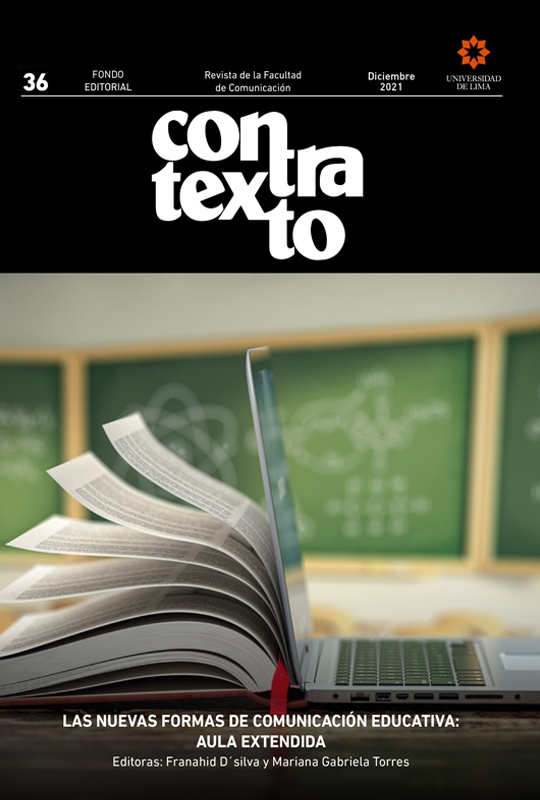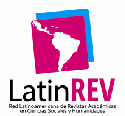El blog colectivo como portal de un espacio de afinidad: desarrollando el aula híbrida en una clase universitaria en Colombia
DOI:
https://doi.org/10.26439/contratexto2021.n036.5232Palabras clave:
espacio de afinidad, aprendizaje conectado, blog, aula híbrida, innovación educativaResumen
El artículo presenta un estudio de caso sobre una experiencia de aula híbrida desarrollada en una clase universitaria de Comunicación Social en Colombia, en la que se construyó un espacio de afinidad por medio del uso de tecnologías de la información y la comunicación (TIC). Utilizando las teorías de espacio de afinidad (Gee, 2003, 2005, 2017) y aprendizaje conectado (Ito et al., 2013), y con base en datos cualitativos recolectados durante cuatro iteraciones de la clase Comunicación e Interactividad (2019-2, 2020-1, 2020-2 y 2021-1), en el análisis del caso reflexiono sobre el proceso de construcción de un espacio de afinidad y sobre el diseño e implementación de un blog colectivo. Por medio del análisis de los contenidos e interacciones que se crearon en el espacio de afinidad, particularmente en el blog, indago sobre las posibilidades para la enseñanza y el aprendizaje que ofrece diseñar entornos centrados en la producción, conectados en red y con un propósito compartido. Los resultados del estudio confirman que el blog colectivo es una herramienta útil para construir espacios de afinidad, promover el aprendizaje conectado y desarrollar aulas híbridas.
Descargas
Referencias
Acevedo-Rincón, J., y Flórez-Pabón, C. (2020). Virtual Education in the Colombian Context:Teaching Practices in Public and Private Education. Pesquisa e Ensino, Barreiras (BA), Brasil, 1(e202027), 1-21.
Asinsten, J. C. (2013). Aulas expandidas: la potenciación de la educación presencial. Revista de la Universidad de La Salle, 60, 97-113.
Black, R. W. (2005). Access and Affiliation: The Literacy and Composition Practices of English Language Learners in an Online Fanfiction Community. Journal of Adolescent & Adult Literacy, 49(2), 118-128.
Boyd, P. (2013). Blogging in the Classroom: Using Technologies to Promote Learner Centered Pedagogies. Researcher: An Interdisciplinary Journal, 26(3), 85-11.
Centro Nacional de Consultoría. (2020). Radiografía de la era digital en Colombia. https://www.centronacionaldeconsultoria.com/post/radiografia-de-la-era-digital-en-colombia-cnc-2020
Cheng, G., y Chau, J. (2011). A Comparative Study of Using Blogs and Wikis for Collaborative Knowledge Construction. International Journal of Instructional Media, 38(1), 71-78.
Cope, B., y Kalantzis, M. (2000). Introduction: Multiliteracies: The Beginnings of an Idea. En B. Cope y M. Kalantzis (Eds.), Multiliteracies: Literacy Learning and the Design of Social Futures (pp. 3-8). Routledge.
Curwood, J. S. (2013). The Hunger Games: Literature, Literacy, and Online Affinity Spaces. Language Arts, 90(6), 417-427.
Deng, L., y Yuen, A. H. (2011). Towards a Framework for Educational Affordances of Blogs. Computers & Education, 56(2), 441-451. doi:10.1016/j.compedu.2010.09.005
Dewey, J. (1916). Democracy and Education. Macmillan.
Duart, J. M., Gil, M., Pujol, M., y Castaño, J. (2008). La universidad en la sociedad RED. UOC; Ariel.
Ferdig, R. E., y Trammell, K. D. (2004). Content Delivery in the ‘Blogosphere’. THE Journal (Technological Horizons in Education), 31(7), 12-16.
Fook, J. (1999). Critical Reflectivity in Education and Practice. En B. Pease y J. Fook (Eds.), Transforming Social Work Practice: Postmodern Critical Perspectives (pp. 195-208). Allen and Unwin.
Freire, P. (1974). La educación como práctica de la libertad. Siglo XXI Editores.
Galvis, A., Mariño, O., y Osorio, L. (2016). Innova-TE 330. Investigando la innovación con TIC en educación. Universidad de los Andes, Facultad de Educación; Centro de Innovación en Tecnología y Educación (Conecta-TE).
García, E., Elbeltagi, I., Brown, M., y Dungay, K. (2015). The Implications of a Connectivist Learning Blog Model and the Changing Role of Teaching and Learning. British Journal of Educational Technology, 46(4), 877-894. doi:10.1111/bjet.12184
García-Roca, A. (2016). Prácticas lectoras en espacios de afinidad: formas participativas en la cultura digital. Ocnos, 15(1), 42-51. doi:10.18239/ocnos_2016.15.1.979
Gee, J. P. (2003). What Video Games Have to Teach Us About Learning and Literacy. Palgrave Macmillan.
Gee, J. P. (2005). Semiotic Social Spaces and Affinity Spaces: From The Age of Mythology to Today’s Schools. En D. Barton (Ed.), Beyond Communities of Practice: Language, Power and Social Context (pp. 214-232). Cambridge University Press. doi:10.1017/CBO9780511610554.012
Gee, J. P. (2007). Good Video Games and Good Learning: Collected Essays on Video Games,Learning and Literacy. Peter Lang.
Gee, J. P. (2015). The New Literacy Studies. En J. Rowsell y K. Pahl (Ed.), The Routledge Handbook of Literacy Studies. Routledge Handbooks Online. https://www.routledgehandbooks.com/doi/10.4324/9781315717647.ch2
Gee, J. P. (2017). Affinity Spaces and 21st Century Learning. Educational Technology, 57(2), 27-31.
González, S. (19 de agosto del 2019). Tumblr, la historia de una popular red social que ha terminado en el ostracismo. El País. https://elpais.com/tecnologia/2019/08/15/actualidad/1565860989_184909.html
Hall, H., y Davison, B. (2007). Social Software as Support in Hybrid Learning Environments: The Value of the Blog as a Tool for Reflective Learning and Peer Support. Library & Information Science Research, 29(2), 163-187.
Ito, M., Arum, R., Conley, D., Gutiérrez, K., Kirshner, B., Livingstone, S., Michalchik, V., Penuel, B., Peppler, K., Pinkard, N., Rhodes, J., Salen, K., Schor, J., Sefton-Green, J., y Watkins S. C. (2020). The Connected Learning Research Network: Reflections on a Decade of Engaged Scholarship. Connected Learning Alliance.
Ito, M., Baumer, S., Bittanti, M., Boyd, D., Cody, R., Stephenson, B., Horst, H., Lange, P., Mahendran, D., Martínez, K., Pascoe, D., Robinson, L., Sims, C., y Tripp, L. (2010). Hanging Out, Messing Around, and Geeking Out: Kids Living and Learning with New Media. MIT Press.
Ito, M., Gutiérrez, K., Livingstone, S., Penuel, B., Rhodes, J., Salen, K., Schor, J., Sefton Green, J., y Watkins, S. C. (2013). Connected Learning: An Agenda for Research and Design. Digital Media and Learning Research Hub.
Ito, M., Martin, C., Cody, R., Rafalow, M., Salen, K., y Wortman, A. (2018). Affinity Online: How Connection and Shared Interest Fuel Learning. New York University Press.
Jenkins, H. (2009). Confronting the Challenges of Participatory Culture: Media Education for the 21st Century. MIT Press.
Kafai, Y. B., y Burke, Q. (2016). Connected Gaming: What Making Video Games can Teach Us about Learning and Literacy. The MIT Press.
Kress, G. (2010). Multimodality: A Social Semiotic Approach to Contemporary Communication. Routledge.
Kress, G., y Van Leeuwen, T. (2001). Multimodal Discourse: The Modes and Media of Contemporary Communication. Arnold.
Lammers, J., Curwood, J. S., y Magnifico, A. (2012). Toward an Affinity Space Methodology: Considerations for Literacy Research. English Teaching-Practice and Critique, 11, 44-58.
Lankshear, C., y Knobel, M. (2006). Digital Literacy and Digital Literacies: Policy, Pedagogy and Research Considerations for Education. Nordic Journal of Digital Literacy, 1(1), 12-24.
Lankshear, C., y Knobel, M. (2007). Online Memes, Affinities, and Cultural Production. En M. Knobel y C. Lankshear (Ed.), A New Literacies Sampler (pp. 199-227). Peter Lang.
Lave, J., y Wenger, E. (1991). Situated Learning: Legitimate Peripheral Participation. Cambridge University Press.
Lugo, N., Melón, M. E., y Castillo M. C. (2017). La representación del autismo en las narrativas de fan fiction.net: los espacios de afinidad como oportunidad para la negociación de sentido. Palabra Clave, 20(4), 948-978. doi:10.5294/pacla.2017.20.4.5
Magnifico, A. M., Lammers, J. C., y Fields, D. A. (2018). Affinity Spaces, Literacies, and Classrooms: Tensions and Opportunities. Literacy, 52(3), 145-152.
Mejía Gallegos, C., Michalón, R., López, R., Palmero, D., y Sánchez, S. (2017). Espacios de aprendizaje híbridos. Hacia una educación del futuro en la Universidad de Guayaquil. MediSur, 15(3), 350-355. https://www.redalyc.org/pdf/1800/180051460010.pdf
Ministerio de Tecnologías de la Información y las Comunicaciones. (abril, 2020). Acceso móvil a internet. En Boletín Trimestral de las TIC. Cifras Cuarto Trimestre del 2019 (pp. 19-33). https://colombiatic.mintic.gov.co/679/articles-135691_archivo_pdf.pdf
Mortari, L. (2015). Reflectivity in Research Practice: An Overview of Different Perspectives. International Journal of Qualitative Methods, 14(5), 1-9. https://journals.sagepub.com/doi/pdf/10.1177/1609406915618045
Nackerud, S., y Scaletta, K. (2008). Blogging in the Academy. New Directions for Student Services, 2008(124), 71-87. doi:10.1002/ss.296
Osorio, L. A. (2010). Características de los ambientes híbridos de aprendizaje: estudio de caso de un programa de posgrado de la Universidad de los Andes. Revista de Universidad y Sociedad del Conocimiento (RUSC), 7(1), 1-9.
Scolari, C. A. (2016). Alfabetismo transmedia. Estrategias de aprendizaje informal y competencias mediáticas en la nueva ecología de la comunicación. Telos: Cuadernos de Comunicación e Innovación, 103, 12-23.
Sim, J. S., y Hew, K. F. (2010). Review: The Use of Weblogs in Higher Education Settings: A Review of Empirical Research. Educational Research Review, 5(2), 151-163. doi:10.1016/j.edurev.2010.01.001
Stephens, M. (2016). Connected Learning: Evaluating and Refining an Academic Community Blogging Platform. Journal of Education for Library and Information Science, 57(4), 295-310.
Vygotsky, L. S. (1978). Mind in Society: the Development of Higher Psychological Processes. Harvard University Press.
Wang, Y., Lin, H., y Liao, Y. (2012). Investigating the Individual Difference Antecedents of Perceived Enjoyment in Students’ Use of Blogging. British Journal of Educational Technology, 43(1), 139-152. doi:10.1111/j.1467-8535.2010.01151.x
Wenger, E. (1998). Communities of Practice: Learning, Meaning and Identity. Cambridge University Press.
Xie, Y., Ke, F., y Sharma, P. (2008). The Effect of Peer Feedback for Blogging on College Students’ Reflective Learning Processes. Internet and Higher Education, 11(1), 18-25.
Descargas
Publicado
Número
Sección
Licencia
Todos los trabajos publicados están sujetos a una licencia CC BY 4.0 Creative Commons (actualizado el 1 de marzo de 2021).
El contenido de la revista se puede compartir en cualquier material o formato. Asimismo, se puede adaptar, contribuir y transformar. Ambas posibilidades sólo están permitidas en la medida en que cumplan las siguientes condiciones:
- Atribución: Se debe otorgar crédito donde sea debido, proporcionar un enlace a la licencia e indicar los cambios en caso se realice alguno. Esto debe hacerse de la manera que se considere apropiada, sin sugerir que el licenciante lo promueva a usted o su uso del material.
Derechos de propiedad
Los derechos patrimoniales de Contratexto se publican bajo una licencia Creative Commons BY 4.0, lo que permite a los autores mantener los derechos patrimoniales de su obra sin restricciones.
Si un trabajo publicado en Contratexto fuera copiado, distribuido, difundido o cualquier otra actividad contemplada en la licencia antes mencionada, se deberá mencionar de manera visible y expresa al autor o autores y a la revista.
Auto-archivo
Esta revista permite y anima a los autores/as a publicar artículos enviados a la revista en sus sitios web personales o en depósitos institucionales, tanto antes como después de su publicación en esta revista, siempre y cuando proporcionen información bibliográfica que acredite, si procede, su publicación en ella.


















